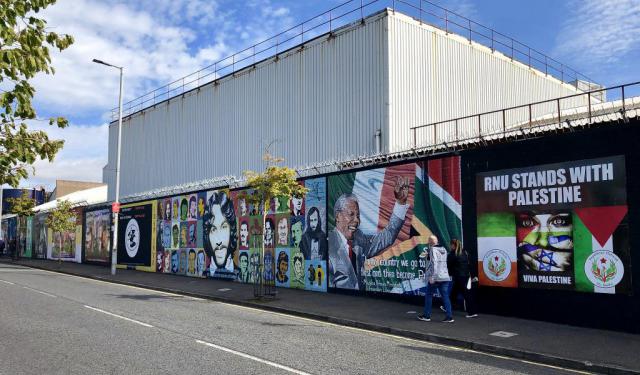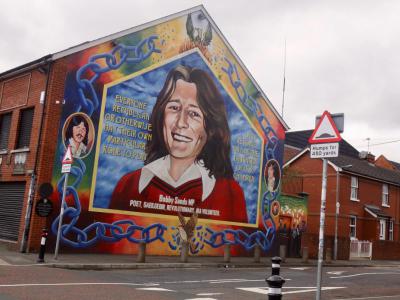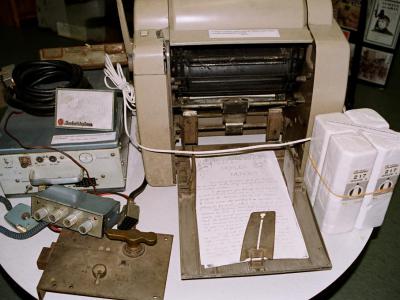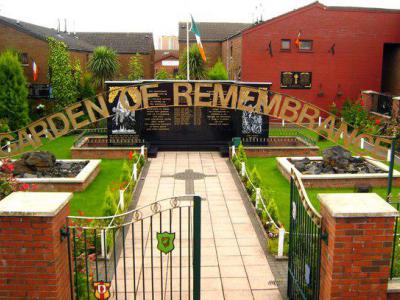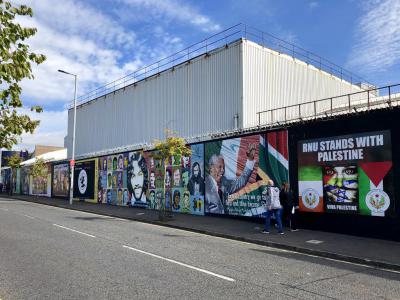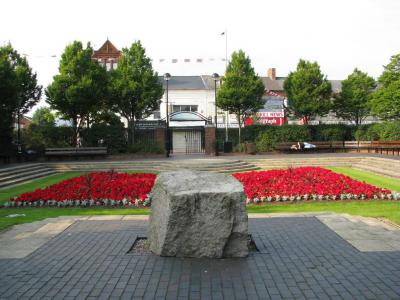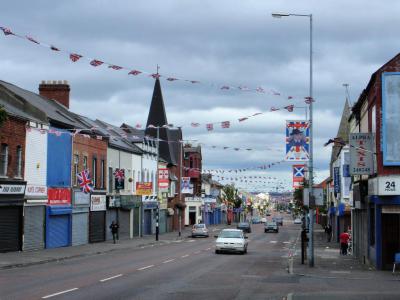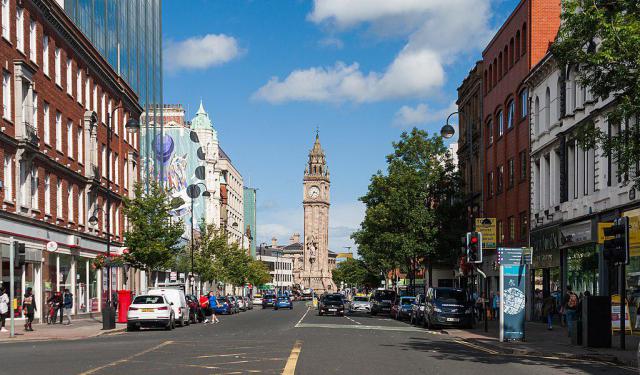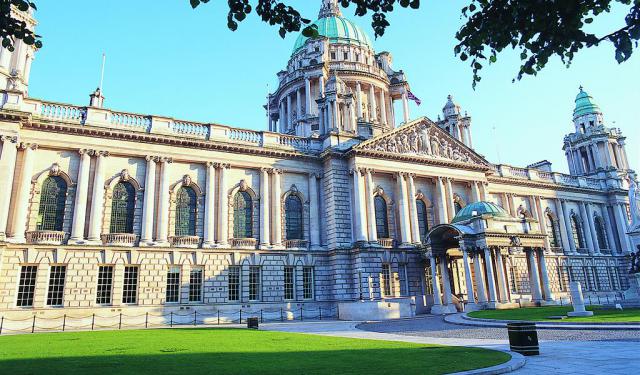The Troubles and Peace Process Landmarks (Self Guided), Belfast
Decades past the official end of The Troubles in Belfast, the price of peace in Northern Ireland remains high. One of the means with which to secure it, back in 1969, was erecting a wall to physically separate the capital's warring Protestant and Catholic communities. Known since as the Peace Wall, the structure has become a popular tourist attraction for the multiple murals painted thereon ever since – some talking of harmony, whilst others carrying messages of revenge or oppression.
Walking down the Catholic Falls Road and Protestant Shankill Road in Belfast, you can find many other signs of division, too. Being reminders of the past, they also serve as symbols of the present, quite somber yet still worth learning about, including:
Bobby Sands Mural – a world-famous painting of the Irish Republican Army leader and elected member of the UK parliament, who died in prison from a hunger strike.
Irish Republican History Museum – holding a collection of artifacts and relics related to the period in the Northern Irish history, known as The Troubles.
Garden of Remembrance – a memorial garden dedicated to the IRA members killed during The Troubles, as well as civilians and deceased ex-prisoners.
Shankill Road Memorial Gardens – a memorial to the victims of bomb explosion on Shankill Road, carried out by the IRA in October 1993 in an attempt to assassinate the Ulster Defence Association leadership.
To explore these and other sights of Belfast that tell the story of The Troubles and peace process via artwork and other media, take this self-guided walk and expand your horizons.
Walking down the Catholic Falls Road and Protestant Shankill Road in Belfast, you can find many other signs of division, too. Being reminders of the past, they also serve as symbols of the present, quite somber yet still worth learning about, including:
Bobby Sands Mural – a world-famous painting of the Irish Republican Army leader and elected member of the UK parliament, who died in prison from a hunger strike.
Irish Republican History Museum – holding a collection of artifacts and relics related to the period in the Northern Irish history, known as The Troubles.
Garden of Remembrance – a memorial garden dedicated to the IRA members killed during The Troubles, as well as civilians and deceased ex-prisoners.
Shankill Road Memorial Gardens – a memorial to the victims of bomb explosion on Shankill Road, carried out by the IRA in October 1993 in an attempt to assassinate the Ulster Defence Association leadership.
To explore these and other sights of Belfast that tell the story of The Troubles and peace process via artwork and other media, take this self-guided walk and expand your horizons.
How it works: Download the app "GPSmyCity: Walks in 1K+ Cities" from Apple App Store or Google Play Store to your mobile phone or tablet. The app turns your mobile device into a personal tour guide and its built-in GPS navigation functions guide you from one tour stop to next. The app works offline, so no data plan is needed when traveling abroad.
The Troubles and Peace Process Landmarks Map
Guide Name: The Troubles and Peace Process Landmarks
Guide Location: Ireland » Belfast (See other walking tours in Belfast)
Guide Type: Self-guided Walking Tour (Sightseeing)
# of Attractions: 6
Tour Duration: 1 Hour(s)
Travel Distance: 2.1 Km or 1.3 Miles
Author: DanaOffice
Sight(s) Featured in This Guide:
Guide Location: Ireland » Belfast (See other walking tours in Belfast)
Guide Type: Self-guided Walking Tour (Sightseeing)
# of Attractions: 6
Tour Duration: 1 Hour(s)
Travel Distance: 2.1 Km or 1.3 Miles
Author: DanaOffice
Sight(s) Featured in This Guide:
- Bobby Sands Mural
- Irish Republican History Museum
- Garden of Remembrance
- Peace Wall
- Shankill Road Memorial Gardens
- Shankill Road
1) Bobby Sands Mural
The Bobby Sands Mural is a world-famous portrait of the IRA leader. It is painted on the walls of the Sinn Fein Political Party Press Office at the corner of Sevastopol Street and Falls Road. It is based on a photograph taken of Sands while he was imprisoned.
In 1977, Bobby Sands was imprisoned in Long Kesh Maze Prison for 14 years for gun possession along with a number of other IRA members and leaders. While in prison, Sands and his cohorts demanded that they not be forced to wear prison uniforms or do prison work. They also wanted to be able to associate with other prisoners and receive visitors and/or packages. Denied these demands, Sands and the others went on a hunger strike.
Sands was elected to the UK parliament during his time in prison. However, he died from the hunger strike before he was able to take his seat. This mural of his smiling face was created as a memorial in 1998. It is one of many murals in Belfast, but is arguably the most well known.
In 1977, Bobby Sands was imprisoned in Long Kesh Maze Prison for 14 years for gun possession along with a number of other IRA members and leaders. While in prison, Sands and his cohorts demanded that they not be forced to wear prison uniforms or do prison work. They also wanted to be able to associate with other prisoners and receive visitors and/or packages. Denied these demands, Sands and the others went on a hunger strike.
Sands was elected to the UK parliament during his time in prison. However, he died from the hunger strike before he was able to take his seat. This mural of his smiling face was created as a memorial in 1998. It is one of many murals in Belfast, but is arguably the most well known.
2) Irish Republican History Museum
The Irish Republican History Museum offers visitors a thought-provoking window into one of the most turbulent and defining chapters of Ireland’s past. Located in the historic Falls Road area, the museum was established in 2007 by the late former republican prisoner Eileen Hickey. Its mission is to preserve and present the story of Ireland’s struggle for independence and the long period of conflict known as “the Troubles,” with a particular focus on the experiences of republican communities in Belfast.
Inside, the museum’s exhibits are both poignant and powerful. Visitors encounter a wide range of artifacts, from personal belongings of political prisoners to uniforms, posters, photographs, and artwork created during imprisonment. These objects tell deeply human stories of resilience, loss, and defiance, offering an intimate perspective that complements the broader historical narratives found elsewhere in the city. The museum also highlights the role of women in the republican movement, reflecting Hickey’s own commitment to ensuring female voices were not overlooked.
For many travelers, a visit here is an opportunity to better understand the complexities of Northern Ireland’s past. The displays present both the struggles and the cultural expressions of a community that lived through decades of conflict, allowing visitors to engage with history on a personal level. Beyond artifacts, the museum hosts talks, events, and temporary exhibitions that continue to explore themes of identity, politics, and social change.
A stop at the Irish Republican History Museum is not only an encounter with objects, but with memory itself. It offers a chance to reflect on Belfast’s layered history, the costs of division, and the enduring hope for peace and reconciliation that shapes the city today.
Inside, the museum’s exhibits are both poignant and powerful. Visitors encounter a wide range of artifacts, from personal belongings of political prisoners to uniforms, posters, photographs, and artwork created during imprisonment. These objects tell deeply human stories of resilience, loss, and defiance, offering an intimate perspective that complements the broader historical narratives found elsewhere in the city. The museum also highlights the role of women in the republican movement, reflecting Hickey’s own commitment to ensuring female voices were not overlooked.
For many travelers, a visit here is an opportunity to better understand the complexities of Northern Ireland’s past. The displays present both the struggles and the cultural expressions of a community that lived through decades of conflict, allowing visitors to engage with history on a personal level. Beyond artifacts, the museum hosts talks, events, and temporary exhibitions that continue to explore themes of identity, politics, and social change.
A stop at the Irish Republican History Museum is not only an encounter with objects, but with memory itself. It offers a chance to reflect on Belfast’s layered history, the costs of division, and the enduring hope for peace and reconciliation that shapes the city today.
3) Garden of Remembrance
The Garden of Remembrance is a solemn yet serene tribute that speaks volumes to Ireland’s recent history. Officially opened on 24 June 2001 and commissioned by the Falls Cultural Society, it stands today as one of the most poignant Republican memorial gardens in the city. Small yet thoughtfully designed, this space brings together horticulture and heritage: an iron gate ushers you toward a paved patio flanked by neat planting beds, leading to a prominent plaque under a proud Irish Tricolour.
At its heart, the Garden honours the members of “D” Company, 2nd Battalion of the Provisional Irish Republican Army, alongside civilians from the Falls Road community who tragically lost their lives during The Troubles. It also commemorates former prisoners who died on hunger strike in 1981 at Long Kesh’s H‑Blocks. The central plaque bears bilingual inscriptions-Irish and English-proclaiming the residents’ dedication: “to those brave and gallant vols … who made the supreme sacrifice in their quest for Irish Freedom”.
For tourists, this Garden of Remembrance offers more than historical context; it invites quiet reflection amidst Belfast’s vibrant atmosphere. It provides insight into local identity, the power of community memory, and the lingering impact of a city striving towards peace. Placed along the mural-lined Falls Road-home to an array of political artworks-this memorial deserves inclusion in any thoughtful walking tour. Visitors are encouraged to approach with respect, allowing time to read the inscriptions, absorb the atmosphere, and contemplate the stories embedded in this living homage to resilience and remembrance.
At its heart, the Garden honours the members of “D” Company, 2nd Battalion of the Provisional Irish Republican Army, alongside civilians from the Falls Road community who tragically lost their lives during The Troubles. It also commemorates former prisoners who died on hunger strike in 1981 at Long Kesh’s H‑Blocks. The central plaque bears bilingual inscriptions-Irish and English-proclaiming the residents’ dedication: “to those brave and gallant vols … who made the supreme sacrifice in their quest for Irish Freedom”.
For tourists, this Garden of Remembrance offers more than historical context; it invites quiet reflection amidst Belfast’s vibrant atmosphere. It provides insight into local identity, the power of community memory, and the lingering impact of a city striving towards peace. Placed along the mural-lined Falls Road-home to an array of political artworks-this memorial deserves inclusion in any thoughtful walking tour. Visitors are encouraged to approach with respect, allowing time to read the inscriptions, absorb the atmosphere, and contemplate the stories embedded in this living homage to resilience and remembrance.
4) Peace Wall (must see)
The Belfast Peace Walls are barriers that separate Protestant and Catholic neighborhoods through the city. They were originally built in 1969 to establish peace by separating sectarian groups. Today, they are popular tourist attractions.
Arguably, the most famous Peace Wall is located between Shankill Road and Falls Road. There is also a large Peace Wall along Cupar Way, which has become a canvas for local artists. Graffiti and street art intermingle on the Peace Walls to provide color to the city while also reminding citizens and tourists of the strife of the country.
The walls were originally meant to be temporary structures. Ironically, the structures have not only stayed in place, but have increased in number. The most recent Peace Wall was constructed in 2017. There are now 59 in the city.
The Belfast City Council began a plan to remove the Peace Walls, but the vast majority of residents believe they continue to help quell violence. Still, the plan is for all Peace Walls to be removed in the future.
Arguably, the most famous Peace Wall is located between Shankill Road and Falls Road. There is also a large Peace Wall along Cupar Way, which has become a canvas for local artists. Graffiti and street art intermingle on the Peace Walls to provide color to the city while also reminding citizens and tourists of the strife of the country.
The walls were originally meant to be temporary structures. Ironically, the structures have not only stayed in place, but have increased in number. The most recent Peace Wall was constructed in 2017. There are now 59 in the city.
The Belfast City Council began a plan to remove the Peace Walls, but the vast majority of residents believe they continue to help quell violence. Still, the plan is for all Peace Walls to be removed in the future.
5) Shankill Road Memorial Gardens
The Shankill Road Memorial Garden was constructed as a memorial to victims of a bomb explosion on Shankill Road. The bombing was carried out by the IRA in October 1993 as an attempt to assassinate the UDA leadership. The bombing killed one IRA member, a UDA member and eight citizens. It also wounded over 50 people.
The garden was opened on May 29, 1994. In addition to serving as a memorial to the Shankill Road bombing victims, the garden honors casualties from both World Wars along with other conflicts.
Visitors to the Shankill Road Memorial Garden will find a memorial stone and lamppost. Each contain ashes from the flowers placed at the bombing. The gated garden has floral plots, shade trees and numerous benches.
Shankill Road Memorial Garden is located on Shankill Road next to the West Kirk Presbyterian Church. It is open to visitors 24 hours, seven days per week.
The garden was opened on May 29, 1994. In addition to serving as a memorial to the Shankill Road bombing victims, the garden honors casualties from both World Wars along with other conflicts.
Visitors to the Shankill Road Memorial Garden will find a memorial stone and lamppost. Each contain ashes from the flowers placed at the bombing. The gated garden has floral plots, shade trees and numerous benches.
Shankill Road Memorial Garden is located on Shankill Road next to the West Kirk Presbyterian Church. It is open to visitors 24 hours, seven days per week.
6) Shankill Road
The Shankill Road is the arterial spine of West Belfast, stretching approximately 1.5 miles from the city centre towards the suburb of Woodvale. It arises from the Irish “road of the old church”, in reference to a 5th-century church once located here, remnants of which survive in the adjacent graveyard. Today, the road is a bustling portrait of working‑class loyalist life, lined with shops, schools, churches, and local services serving the Court district.
Once a 19th-century linen hub with streets named after Belgian flax regions, Shankill Road later became a center of loyalist activity during the Troubles. Groups like the Shankill Defence Association and UVF formed here, and the 1993 bombing at Frizzell’s Fish Shop marked a tragic chapter. Today, murals and memorials reflect both pride and remembrance.
Visitors will notice vibrant murals and peace lines peppered along the route, reflecting sectarian tensions while signaling hope. The famous Shankill Graveyard, dating back over a millennium, and the Somme memorial beside it, pay tribute to generations-including soldiers from the 36th Ulster Division. Nearby lie community treasures: the Shankill Women’s Centre, old pubs like the Rex Bar, and various sports facilities dedicated to boxing and football-halls of fame where locals such as Norman Whiteside and Wayne McCullough once trained.
Today, the Shankill Road offers tourists a genuine and complex Belfast experience. From its roots in early Christianity to its industrial heyday and through periods of conflict and reconciliation, this thoroughfare embodies a living neighbourhood. Visitors can explore its poignant memorials, admire street art, and enjoy the community spirit in local cafés, shops, or on a guided walking tour.
Once a 19th-century linen hub with streets named after Belgian flax regions, Shankill Road later became a center of loyalist activity during the Troubles. Groups like the Shankill Defence Association and UVF formed here, and the 1993 bombing at Frizzell’s Fish Shop marked a tragic chapter. Today, murals and memorials reflect both pride and remembrance.
Visitors will notice vibrant murals and peace lines peppered along the route, reflecting sectarian tensions while signaling hope. The famous Shankill Graveyard, dating back over a millennium, and the Somme memorial beside it, pay tribute to generations-including soldiers from the 36th Ulster Division. Nearby lie community treasures: the Shankill Women’s Centre, old pubs like the Rex Bar, and various sports facilities dedicated to boxing and football-halls of fame where locals such as Norman Whiteside and Wayne McCullough once trained.
Today, the Shankill Road offers tourists a genuine and complex Belfast experience. From its roots in early Christianity to its industrial heyday and through periods of conflict and reconciliation, this thoroughfare embodies a living neighbourhood. Visitors can explore its poignant memorials, admire street art, and enjoy the community spirit in local cafés, shops, or on a guided walking tour.
Walking Tours in Belfast, Ireland
Create Your Own Walk in Belfast
Creating your own self-guided walk in Belfast is easy and fun. Choose the city attractions that you want to see and a walk route map will be created just for you. You can even set your hotel as the start point of the walk.
Belfast Introduction Walking Tour
For over a century, the political situation of Belfast, the capital of Northern Ireland, has been the source of strife, first between the Crown-loyal Protestants and Irish Catholics, and more recently between the United Kingdom and the European Union.
Sitting on the banks of the River Lagan where it meets the Irish Sea, the city owes its name to this coastal condition, with "Belfast"... view more
Tour Duration: 2 Hour(s)
Travel Distance: 3.8 Km or 2.4 Miles
Sitting on the banks of the River Lagan where it meets the Irish Sea, the city owes its name to this coastal condition, with "Belfast"... view more
Tour Duration: 2 Hour(s)
Travel Distance: 3.8 Km or 2.4 Miles
Belfast Victorian Architecture Jewels
Described as “modestly scaled, undemonstrative, somewhat solid in aspect, and usually restrained (sometimes even austere) in its use of external decoration”, the urban landscape of Belfast has been influenced by the demands of shipbuilding and linen industry, much as transitioning between culture, arts, commerce, and education. Still, the architectural spectrum of the city is quite broad and... view more
Tour Duration: 2 Hour(s)
Travel Distance: 2.9 Km or 1.8 Miles
Tour Duration: 2 Hour(s)
Travel Distance: 2.9 Km or 1.8 Miles
The Most Popular Cities
/ view all
